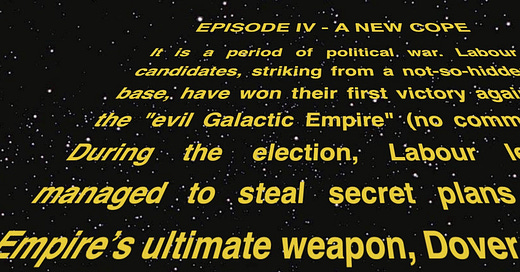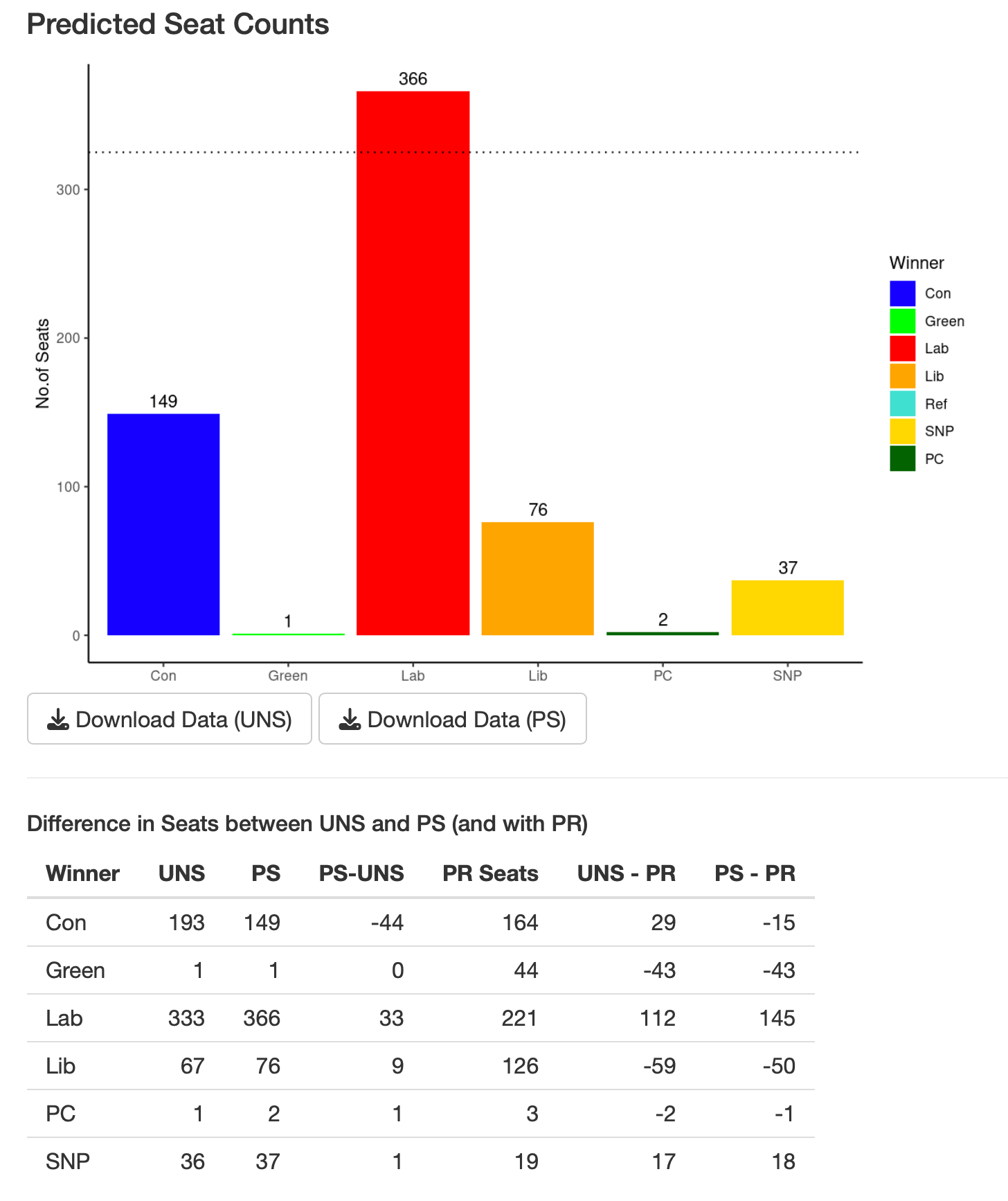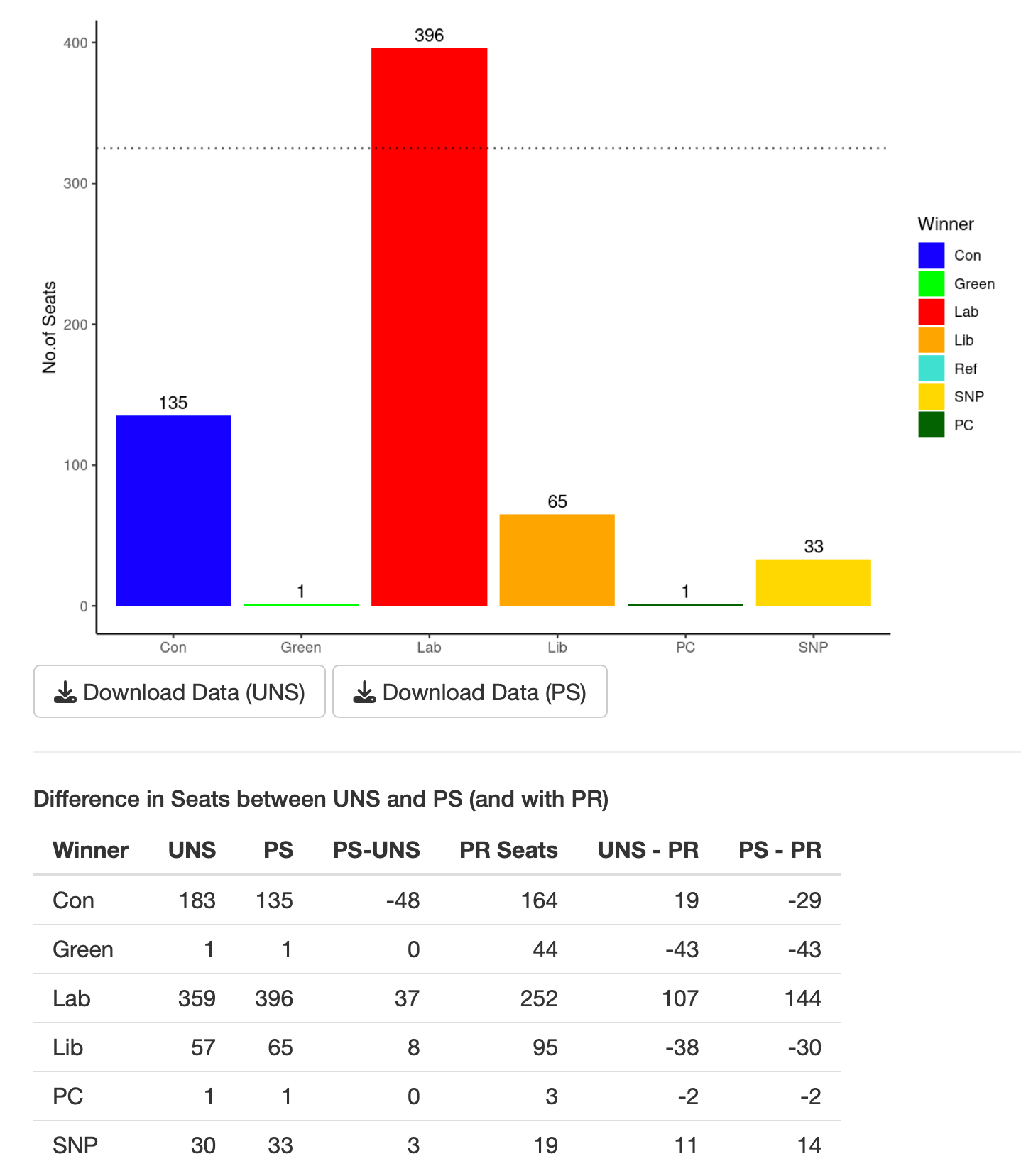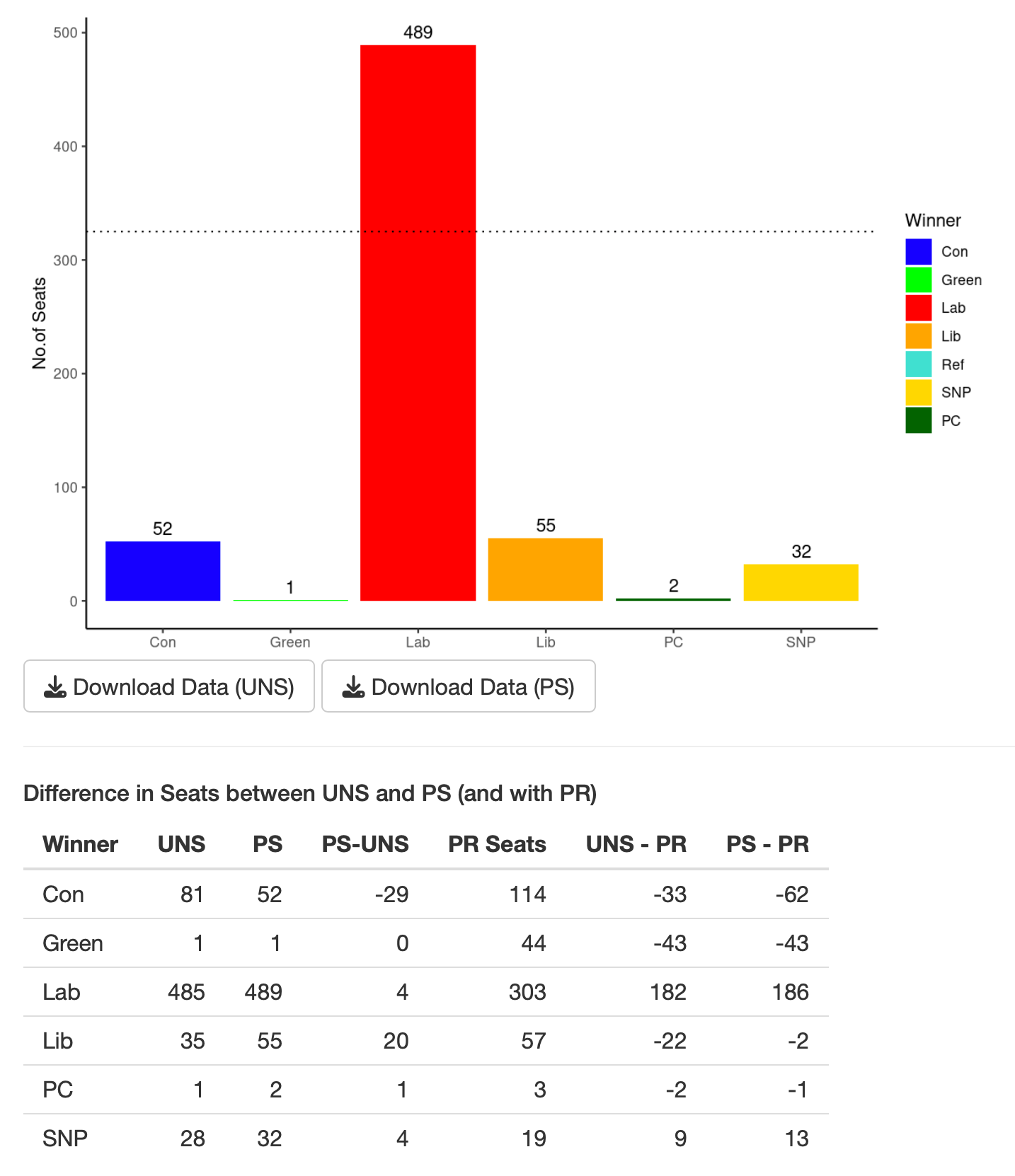Tactical Coping Episode IV: A New Cope
Oh God, we're doing this again after the local elections aren't we...
Were the local elections really good for the Conservatives? Use my app to see. I suspect you’ll have some skepticism.
Who remembers May 2023, eh? The coronation of King Charles III, a new Legend of Zelda game, Erik Ten Hag looking like the long-term future of Manchester United. Oh and a series of local elections that were basically terrible for the Conservative Party but were retro-fitted as maybe not that bad if you took the predicted national vote from the locals and pretended they were the actual national polls.
Because I love any opportunity to advertise my own General Election prediction app, I wrote a lengthy Substack post called ‘Tactical Coping’ (drumroll) arguing that the mismatch between taking the predicted national vote from the locals and the general election polling at the time was caused by the difference between people’s sincere and strategic preferences. The post was a qualified success, in that Emily Maitlis mentioned it on The News Agents, which then encouraged me to write a follow-up piece. And then again another piece on my election prediction app and what happens if you use the new constituency boundaries earlier this year.
So that means this is my fourth post on this topic. Which suggests that I am failing in my mission to prevent Conservative politicians from ingesting industrial qualities of copium. But let’s go one more time for good measure. It also means that I could come up with a tenuous Episode IV - A New Cope gag.
This morning, the Politico Morning Call email, quoting Katy Balls in the Spectator, had the following line: Levido took a shot at the BBC’s polling expert John Curtice for good measure. Levido apparently described Curtice, who recently said the Tories have a 1 percent chance at winning the election, as a mere “political commentator,” and said Thrasher was the true “professional.”
Anyone who is not a British ‘political hobbyist’ (see my last post) might need a translation. Allow me to offer one. The political scientists Michael Thrasher and John Curtice disagree about what the recent local elections mean for the Conservative Party’s prospects in the upcoming General Election. Both Thrasher and Curtice broadly agree on what the pattern of votes in the local elections would mean if we accounted for the geographical distribution of which councils had elections and then aggregated that up to a national vote split. We would end up with something like 35% for Labour, 26% for the Conservatives, 20% for the Lib Dems and 19% for others.
The debate between Curtice and Thrasher is how meaningful this ‘projected national vote’ really is. Curtice basically doesn’t think this is very predictive of what will happen on General Election day - he follows current polling where Labour lead somewhere between 15 and 30 (!) points not the 9 point leave predicted from the locals. For Thrasher his own models suggest a hung parliament - and as we will see in my prediction app we can get that outcome too.
That would be great for the mysterious Mr Levido in the quote above - this is Isaac Levido, the chief electoral strategist for the Conservatives. Levido’s job is twofold - to win the next General Election and to stop Conservatives from collapsing into depression before then. So Thrasher-world is much more attractive than Curtice-ville for Mr Levido. Upton Sinclair famously noted “It is difficult to get a man to understand something, when his salary depends on his not understanding it.” For Levido, his salary depends on Conservative MPs not understanding the pickle they are very likely in.
But really, yes really, they are in a lot of trouble. And the reason is exactly what I said last year, the projected national vote from the local elections is misleading about what might happen on General Election day. In other words, I’m on Team Curtice.
Let’s do a quick recap on what I said last May. Essentially national polls and local election outcomes reflect two different things. Not least, the first is a preference and the second is a behaviour. If we had a fully proportional electoral system then the differences would be minimal because - above a certain threshold - if you supported a party your vote would feed directly into its parliamentary representation.
That, however, is emphatically not the system we live in in the UK. Our national elections happen at the constituency level with just a single plurality winner - the famous ‘first past the post’ or FPTP system. And that encourages tactical voting, where people don’t vote for the party they sincerely want but the one they most like who could win that constituency.
Our local elections are also FPTP at the ward level and hence the results we saw last week reflected at least some tactical voting. In particular, this helps to explain the very high vote share of 20% for the Lib Dems in the projected national vote from the locals, while all the national polls show them hovering around 10%. That alone explains the gap between Labour scoring 35% in the projected national vote and around 45% in polls. The 19% vote for ‘others’ also hides a lot of Green voters, again many of whom might act differently in the local elections than in national polls.
Finally, there is also the Reform Party, currently scoring 12-15% in the national polls but who only ran candidates in around a sixth of councils, receiving just a handful of councillors. In their case, a number of potential Reform Party voters might have bitten their lip and tactically voted Conservative in the locals.
The complicated thing about reading through from the locals is that since wards and constituencies are very different in size and in who turns out to vote, the tactical voting in the locals could look very different from that in the nationals. To give an example, in some Conservative held parliamentary constituencies, Labour might be the clear opponent at the general election, but many council wards could be ones where the chief competition to the Conservatives are Lib Dems. And so we might have Labour voters going Lib Dem at the ward level in the local elections, while Lib Dem voters vote for Labour in the general election. The key thing is that right now it looks like voters for both parties are very happy to vote for one another to get Conservatives out. Tactical voting is working.
And you know who created a general election predictor app with tactical voting? This guy. Because I’m an inveterate centrist / people-pleaser, my solution to the ongoing debate between the supporters of Uniform National Swing (UNS) and those advocating Proportionate Swing (PS) has simply been to adapt my app to do both. But I also allow you to shift some sliders to move some Labour voters to the Lib Dems, Lib Dem voters to Labour, Green voters to Labour, or Reform voters to the Conservatives (yes, I realise this is not completely symmetric but nor is life sadly).
To see how different assumptions about tactical voting matter and why the projected national vote (PNV) might be misleading, let’s see what happens if we plonk the PNV numbers into my app, and then twiddle some knobs. Let’s start naively and assume no tactical voting at all. I’ll give Labour 35, Cons 26, Lib Dems 20, and then will split up the ‘others’ into Reform 10, Greens 7, SNP 3, Plaid 0.5 (which feels about right but feel free to use your own numbers). I’ll show the estimates with Proportionate Swing, which I feel is probably more likely to be holding right now (see this tweet from Lewis Baston), but below the figure show a table comparing UNS results and what would happen under PR.
Good news Isaac! Everything’s fine! Thrasher is right. Go home Conservative MPs and prepare for office. Well not office, but a coalition of chaos that you can attack from opposition seats. And with around 200 seats you’ll be in the same situation as Labour after 2019 so the comeback is on. The quiet party is turning up the volume!
And that’s just with Proportionate Swing, with UNS things are even better for the Conservatives and Labour are under 300 seats. It’s practically a tie!
As long as everyone votes sincerely that is. Because if thirty percent of Labour voters vote Lib Dem in seats where the Lib Dems are second, and if the Lib Dem voters return the favour in seats where Labour are second, well then things change. And let’s also have thirty percent of Green voters back whichever of the Lib Dems or Labour are second. And, be fair, push thirty percent of Reform voters to the Conservatives. Here’s what we get.
Oh… We’re back to not only a pretty large Labour majority but also a collapse below 150 seats (at least for proportionate swing) for the Conservatives. Note this only helps the Liberals a bit, largely because in the projected national vote from the locals they are already doing really well. And even with UNS rather than proportionate swing, Labour still have a majority. Remember this is with the disappointing 35% Labour share but with some tactical voting added.
Now the PNV from the locals presumably includes some tactical voting already and that’s why the LD share is so high (there were a lot of Labour supporters gritting their teeth and voting Lib Dem). So we could split the difference a bit and say the outcome of 35 Lab, 20 Lib Dem, actually comes from something like 40 Lab, 15 Lib Dem but after the tactical voting. So, let’s do that and keep the tactical vote parameters the same.
Oh… that’s even worse. And I suspect for the Conservatives, this is the kind of thing going on. The Lib Dem vote share from the locals was inflated by three things (a) older and richer turnout than general elections, (b) Lib Dems being very good at local politics, and (c) Labour voters trying to keep the Tories out. That third factor is going to be especially important when the general election comes around.
And this is all assuming the locals tell us something. What do we get if we just plug current polls into the app. Actually, let’s just got crazy and put in today’s YouGov poll which was, um bad for the Conservatives. Lab 48, Con 18, LD, 9, Reform 13, Greens 7, SNP 3. Here we go, and with no tactical voting.
Murder. Add a bit of tactical voting to that and you get sub 50 seats for the Conservatives.
Now I don’t think YouGov poll, striking as it is, is a likely outcome on election day. I think quite a few of those Reform voters will come home to the Conservatives and lots of don’t knows and won’t answers will return. The campaign hasn’t yet begun and while I don’t expect the ‘party in the media’ to be especially effective or even loyal (the Murdoch press are clearly backing away from the Conservatives and towards Starmer, if rather unenthusiastically), I still think a summer of Keir-bashing will be somewhat effective.
But I really really don’t think the Thrasher conclusion is helpful for the Conservatives to believe, despite the attraction of magical thinking. Tactical voting will be endemic in the next election and what I hope this Substack has convinced you of is that just a little bit of tactical voting matters a massive amount in the probability of a Labour majority.
There is one person who the Levido-Thrasher line will appeal to though and that’s Morgan McSweeney, Starmer’s campaign manager. The biggest worry for Labour is that a Labour landslide becomes a self-negating prophecy as tactically-voting Lib Dems or Greens think they don’t need to back Labour in Con-Lab marginals and just vote sincerely. A little bit of fear of Conservative government is needed to keep third party voters behaving tactically.
So for Morgan McSweeney, Keir Starmer and Labour, pretending that a hung parliament is on the cards is very handy. They should give Michael Thrasher a knighthood. For Isaac Levido on the other hand, it’s a false cope.
Regular subscribers may have noted that I have not posted recently. Sorry! But since this is a free Substack, also not sorry. Anyways, I have been busy and I promise I have news about various politics and democracy related things I’ve been doing. Soon… So subscribing to this Substack will be worthwhile, promise.
But if you just can’t wait to hear more from me and you don’t already own it, remember Why Politics Fails is out in paperback. It even appeared in airport bookstores, thereby fulfilling a lifelong ambition to write an ‘airport book’. Oh and it’s now out in Germany, Japan, and Korea.









A very interesting analysis, Ben.
I’m looking forward to election night. Will you be live blogging or on TV/radio on that night?